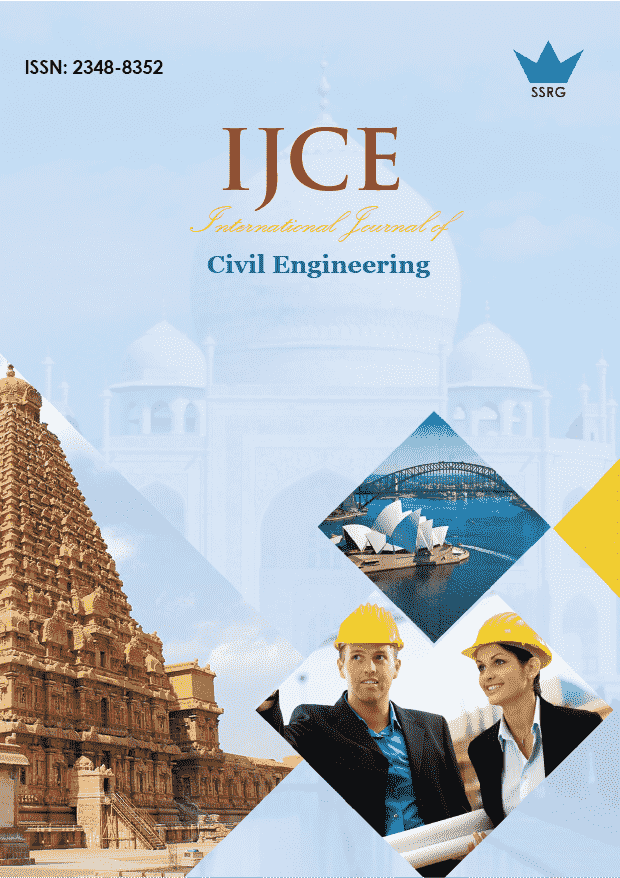Laboratory Studies of Raw Water Treatment using Plaster of Paris (Pop) and Block (Sandcrete) as Filter Media

| International Journal of Civil Engineering |
| © 2019 by SSRG - IJCE Journal |
| Volume 6 Issue 2 |
| Year of Publication : 2019 |
| Authors : Deedam T. Q. andAdemiluyi J. O. |
How to Cite?
Deedam T. Q. andAdemiluyi J. O., "Laboratory Studies of Raw Water Treatment using Plaster of Paris (Pop) and Block (Sandcrete) as Filter Media," SSRG International Journal of Civil Engineering, vol. 6, no. 2, pp. 16-22, 2019. Crossref, https://doi.org/10.14445/23488352/IJCE-V6I2P104
Abstract:
Raw water is characteristic water found in our environment that has not been treated or purified, nor minerals, ions, particles, or living organisms been expelled. Polluted water leads to death in several countries, including Nigeria, as water the major need of every living thing is in crisis. Different innovations and techniques have been used in treating water; however, these techniques are very expensive. This has led to more research using low-cost materials to construct a filter for convenient drinking water purification. The method used in this research was filtration through adsorption in the treatment of raw water, using commercial plaster of Paris and block as a filter for raw water to pass through. The filtrates were then processed for the viable Coliform count, dissolved solids, Turbidity, pH, Temperature, and suspended solids. The filtration unit attained 98% TDS removal, 57% TSS removal, 86% Turbidity removal, 49% Temperature increase, 26% increase in pH, 91.8% of E-Coli removal and 99% of bacteria removal. The results obtained were in accordance with EPA and WHO standards and are recommended for urban reuse.
Keywords:
Plaster of Paris (POP), Block (Sandcrete), Effluent, Raw Water, Filtration.
References:
[1] Tchobanoglous, Burton, and Stensel. Waste Water Engineering Treatment and Reuse. Metcalf & Eddy 4th Edition,. 1140,(2014).
[2] S.Gundry, J. Wright, R. Conroy. A Systematic Review of the Health Outcomes Related to House Hold Water Quality in Developing Countries. Journal on Water and Health, 2(1), (2004),1-13.
[3] W.H.Viessman, E.M Perez, and P.A. Chadik. Water Supply and Pollution Control: Pearson Prentice Hall,(2011).
[4] M.S.Enzler.,http://www.lenntech.com/history-water-treatment.htm Retrieve 06/04/16, (1996).
[5] J.O.Ademiluyi, andN.S.Eluozo Establishmentof Porosity and Permeability Models Correlation to Validate E . Coli, Transport to Ground Water Aquifer; Rivers State On NigeriaFilterability And Compressibility of Sludge, Conclusion. International Journal of Engineering and Technology, 2(1),(2013),17-24.
[6] Claudia Copeland. Waste Water Treatment: Overview and Background. CRS Report, 2014, www.crs.gov Retrieved 06/04/16.
[7] H.Rhoda Gumus. Kinetic Studies of Methylene Blue Adsorption on to Activated Carbon Prepared From Plantain Rod (Musa Paradisiac), British Journal of Applied Science And Technology, 15(3),(2016),1-14.
[8] I.Ali, M. Asim, and T. Khan. ALow Cost Adsorbents for the Removal of Organic Pollutants from Wastewater. Journal of Environmental Management, 113,(2012),170-183. https://doi.org/10.1016/j.jenvman.2012.08.028.
A. H. Nassar, and K. Hajjaj. Purification of Storm Water Using Sand Filter. Journal on Water Resources and Protection, 2, (2013),1007-10012.
[9] EphremGuchi. Review of Slow Sand Filtration in Removing Microbial Contamination and Particles from Drinking Water, American Journal of Food and Nutrition, 3(2),(2015),47-55.
[10] E.Korovessi, and A. A.Linninger. Batch Processes. Taylor and Francis Group, CRC Press, New York., (2006).
[11] S.W.Sanghranta, and T. Arfin. Fluoride Removal from Water by Calcium Materials: A State-Of-The-Art Review, International Journal of Innovative Research in Science, Engineering and Technology (IJIRSET)., 4(9),(2015),8090-8102.
[12] J.I.A.Qazi, A. Naheedaand A. S.Bano, Construction of Low-Cost Filters for Microbiological Purification of Drinking Water, Punjab Univ. J. Zool, 30(1),(2015),21-024.
[13] Nigerian Industrial Standard (NIS). Requirements Nigerian Standard for Drinking Water Quality. NIS 554.15-22,(2007).
[14] EPA. Protecting Water Quality from Agricultural Runoff. Fact sheet No: EPA-841-F-05-001,(2005).
[15] WHO. Guidelines for Drinking Water Quality,.2. Geneva: World Health Organisation, (2000).
[16] K. R. Sankar, B. R. Ventraman, S. Arivoli, and V. Marimuthu. Kinetic, Thermodynamic and Isothermal Studies of the Removal of Methylene Blue Dye using Plaster of Paris, Global Journal of Engineering, Design, and Technology (GJEDT), 2(4),(2013),33-40.
[17] NP.Shukla, P. S. Bundele, S. K Khare, and S. Sarsaiya. Study of the Impact of Plaster of Paris (POP) and Clay Idols Immersion in Water. International Journal of Scientific Engineering and Technology (IJSET). 3(7),(2014) ,861-864.
[18] AF Gaudy, and E. T. Gudy. Microbiology for Environmental Scientists and Engineers. McGraw Hill Books Co., London, (1980).
[19] DS. Francy, D. N. Myres, and K. D Mefzker. Escherichia Coli and Faecal Coliform Bacteria as Indicators of Recreational Water Quality. (US. Geological Survey), (1993).
[20] J.Brown and M. D. Sobsey Microbiological Effectiveness of Locally Produced Ceramic Filters for Drinking Water Treatment in Cambodia. Journal of Water and Health, 8(1), (2010), 1–10.
[21] G.S. Logsdon, T. J. Sorg, and R. M Clark. Capacity and Cost Treatment Technologies for Small System. Journal of American water works Association. 82 ,(1990),60-66.
[22] Sumit Bhardwaj, Sabbir Ahammed Belali, A Review on Retrofitting, SSRG International Journal of Civil Engineering 2(3) ,(2015) , 7-10.

 10.14445/23488352/IJCE-V6I2P104
10.14445/23488352/IJCE-V6I2P104